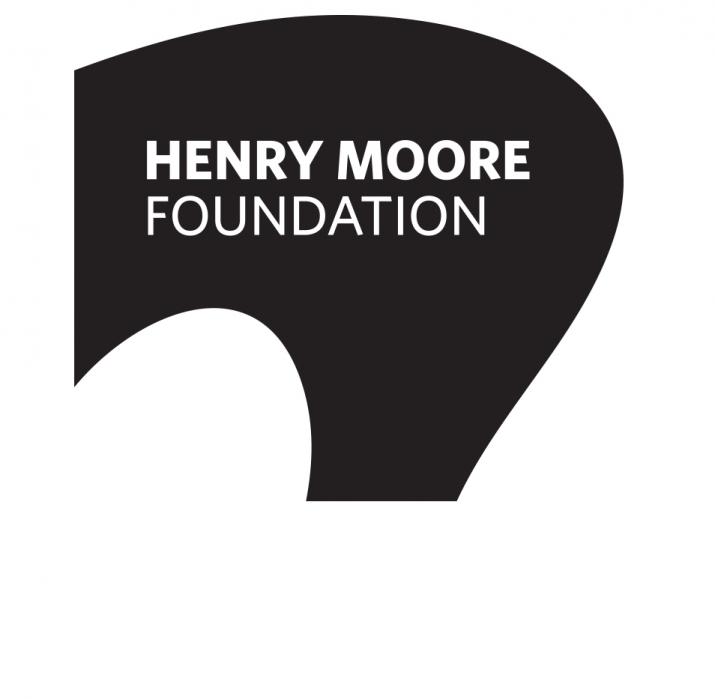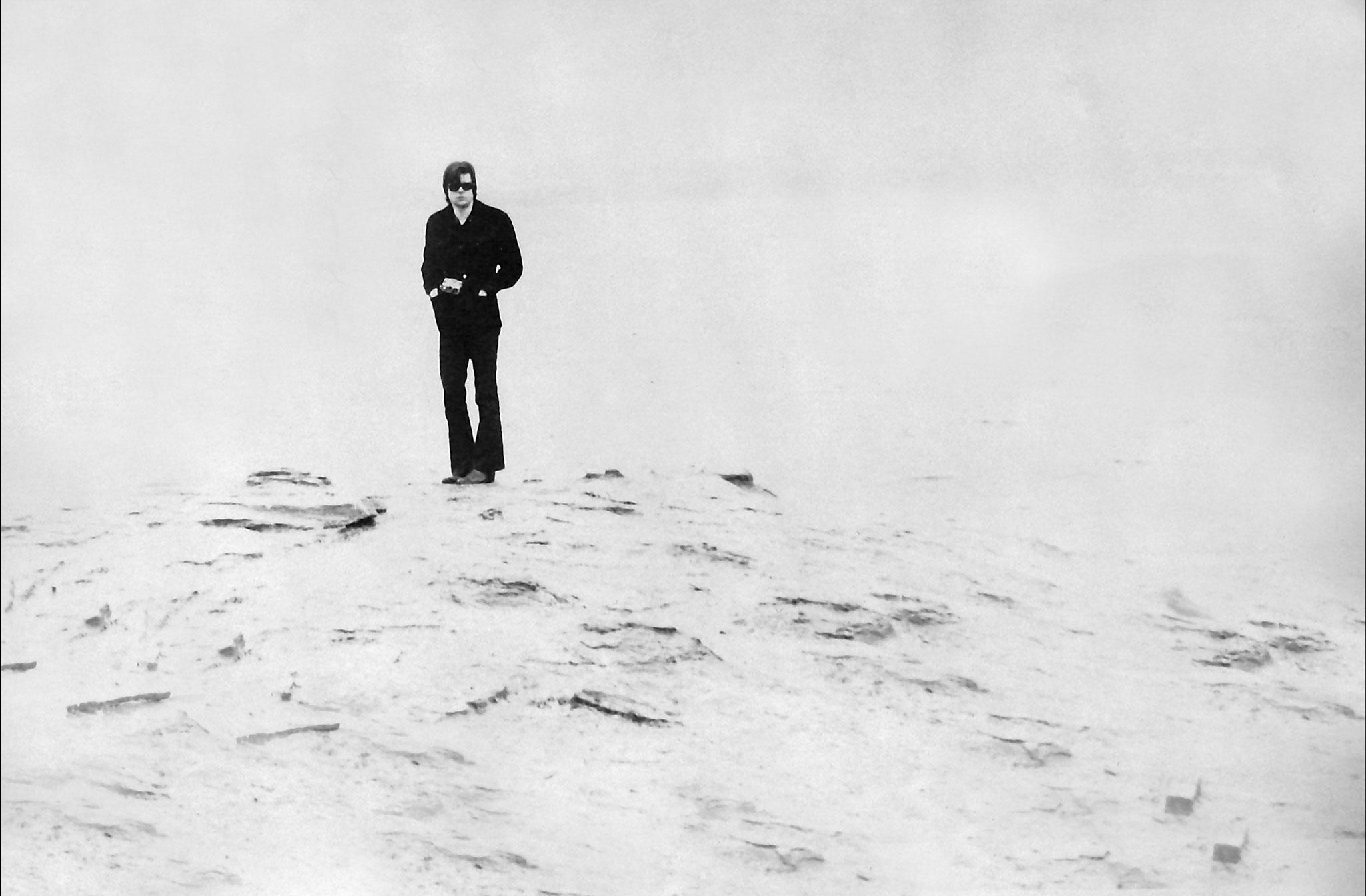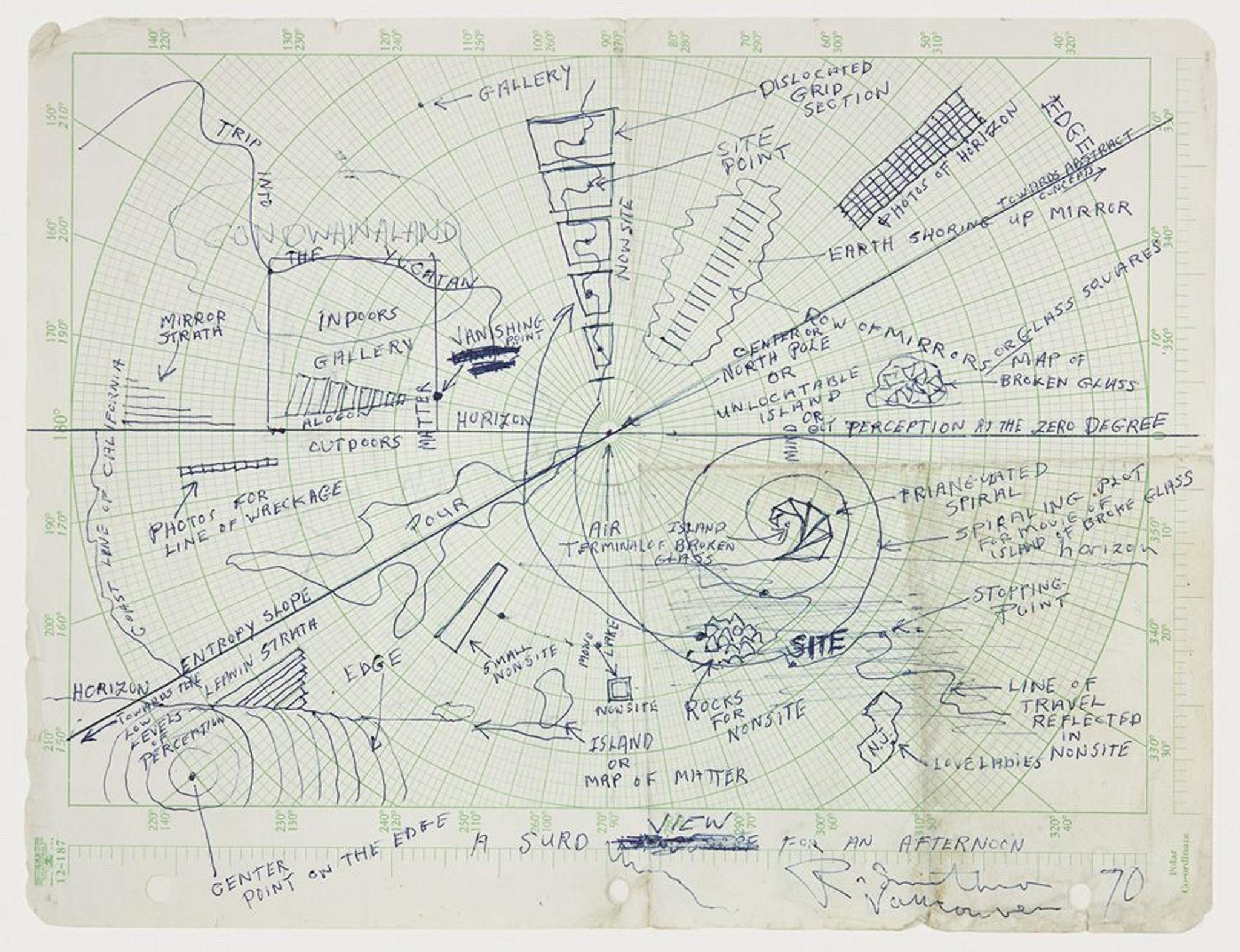
Island of Broken Glass
Robert Smithson searched for lost islands. He might have found one in Miami Islet, but a telegram from the Canadian government in January of 1970, just two days after the seventieth anniversary of the shipwreck that gave the island its name, stopped the Island of Broken Glass project as it would also halt one hundred tons of green-tinted glass on its way to Vancouver’s coastline. If the glass had been deposited on the islet, Island of Broken Glass would have been Smithson’s first permanent earthwork—a milestone that remained elusive until Spiral Jetty later that year.1 The artist’s search for islands and his maps for getting there continued.
Robert Smithson and Nancy Holt look cold and windswept, but focused and content, there on Miami Islet. In other photographs, Smithson’s solitary figure perches on the anticline of sandstone, strewn with timbers. In one he is dressed in black, sunglasses on, in a sea fog; in another the same black figure rides an overexposed midden that blends with the white background. In Gianfranco Gorgoni’s photograph, snapped amid Vancouver’s winter, we don’t see the anticline of sandstone that rifts out of Stuart Channel for about fifty meters, only the artists as they survey the site for Island of Broken Glass. A heavy cloud, dark as smoke, hangs overhead. I imagine this to be the “storm over the island” that Smithson talks about with Dennis Wheeler in a series of interviews made in late 1969 and early 1970.2 Storms above, fissures below, and the island in between. Miami Islet emerged from these perilous waters of the Strait of Georgia in the way that Island of Broken Glass materializes from the swirling, tidal maps that Smithson drew as he talked with Wheeler in Vancouver in late 1969.
As he sketches the map that would become the drawing A Surd View for an Afternoon (1969-70), Smithson’s works float across a sheet of polar coordinate paper, the kind commonly used for plotting navigational routes.3 The map inventories the breadth of his work as it also indexes his island projects. The drawing’s eccentric epicenter is Island of Broken Glass, which rests at the origin of an Archimedean spiral, like a whirlpool pulling in other projects and tracing the genealogy of Island of Broken Glass. Earlier that year, in April, when he discussed the eighth chapter of the 1969 work Yucatán Mirror Displacements 1–9 set up on an eroding island of river sediment, Smithson had asked a question that Island of Broken Glass would seek to answer: “Where is the island? The unknowable zero island?”4 He had also alluded to a project with broken glass on the Jersey shore: “The map is a series of ‘upheavals’ and ‘collapses’—a strata of unstable fragments is arrested by the friction of stability.”5
For twenty days in July 1969 Map of Broken Glass (Atlantis) occupied a beach in Loveladies along the New Jersey coast. It’s there on the map Smithson draws with Wheeler, right next to the “unlocatable island” that annotates the pole at the center of the page, just ten degrees above the zero-degree line that Smithson has labelled “horizon.” The Loveladies project steers us back to his drawing for Map of Broken Clear Glass that locates itself in the center of Atlantis (as it was mapped by Lewis Spence), quantifies tons of broken glass, and outlines how the hypothetical project would be assembled. With these precedents, Smithson summarized for Wheeler both the map he was drawing and the project he was planning for Miami Islet: “You have a string of hypothetical islands that finally find their result in an actual island.”6
The “actual island” required actual land. In December 1969, Smithson alluded to the emergent project during an interview in Rome: “I’m very interested right now only in land for the work to be on, in other words the work of art needs actual land. When I go back to the United States, I have planned to cover a whole island with broken glass.”7 The previous month, with the help of art dealer Douglas Christmas, Smithson had scouted for “a small island with an area no larger than a quarter of a small block” and with the following attributes: “wind swept, preferably flatish and barren, in short an island that would have no commercial value.”8 Tiny and isolated, Miami Islet met the criteria Smithson sought. It was an “allusive” and “ungraspable” place.9 It was also dangerous and prone to accident. At seven in the morning of January 25 in 1900, the collier steamship Miami ran aground here. Smithson would have seen traces of its wreckage, even though he might not have known the ship had circumnavigated the coastal edges of his other work along Florida’s peninsula and Manhattan’s island.10
The island was a place that explored dialectics as it also became a site that crystallized debates. With Island of Broken Glass, Smithson was working toward the “physical equivalence of a mental image” in order to present a dialogue between perception and matter, between broken glass and barren island.11 But its mix of an actual place with displaced material caused debate among those who hailed the project’s reclamation of a “wasteland area” and others who foresaw environmental degradation, or saw the broken glass as just so much “U.S. garbage” dumped across the border.12 The material was on its way from Stockton, California when the telegram halted the project. For critics, the project also encroached on forbidden areas of nature and sovereignty. In many ways, Smithson already knew this. He already understood the island as a “taboo territory” where the project could confront ambiguities of matter, nature, and ecology without imposing order.13 For Smithson, the collision of glass and island would make a place where the “tension of disparates” came together—the kind of place where, as Mary Douglas noted, “disparate elements are related and disparate experience is given meaning.”14
After the rejection of Island of Broken Glass, Smithson proposed a new project that would deposit materials from a Vancouver demolition site on the islet. In February 1970, Smithson called Island of the Dismantled Building a “monument to ecology.”15 It offered an environmental approach in which humans and nature were not in opposition. At the same time, the proposed project did not place nature somewhere else, and it did not ignore human production and waste. It explicitly combined wasteland with wilderness.16
Perhaps all of Smithson’s projects appear as thresholds, each a waypoint to the next in a continually redrawn map. Island of Broken Glass certainly pointed toward Spiral Jetty, but it is significant in its own right—a reckoning of sorts. Mariners might call it a dead reckoning that navigates between temporary and permanent toward that “wreck of precision” and its island—a spiraling film that might yet remain in place, frozen for a time. Its spirals are so many concentric rings around the island, like a pebble tossed in the ocean.17 And so Island of Broken Glass anchors an archipelago of projects where each island is a working hypothesis, never meant to be resolutely found or fully realized. Each probes and adjudicates. With Island of Broken Glass, Smithson tacked toward the “unknowable zero island,” and then held up a mirror: “It is not for us to judge the island but for the island to judge us."18
Selected Bibliography
Arnold, Grant. Robert Smithson in Vancouver: A fragment of a greater fragmentation. Vancouver: Vancouver Art Gallery, 2004.
Douglas, Mary. Purity and Danger. New York: Praeger, 1966.
Hailey, Charlie. Spoil Island: Reading the Makeshift Archipelago. New York: Rowman and Littlefield, 2013.
Smithson, Robert. “Incidents of Mirror-Travel in the Yucatán,” Artforum, Sept. 1969: 28-33.
Smithson, Robert. “Four Conversations between Dennis Wheeler and Robert Smithson,” edited by Eva Schmidt. In Robert Smithson: The Collected Writings, edited by Jack Flam, 196-233. Berkeley: University of California Press, 1996.
About the Author
Charlie Hailey is an architect, writer, and professor in the School of Architecture at the University of Florida. A Guggenheim Fellow and Fulbright Scholar, he is the author of six books, including Camps: A Guide to 21st Century Space (2009) and Slab City: Dispatches from the Last Free Place (2018), a project in collaboration with Donovan Wylie. Hailey’s newest The Porch: Meditations on the Edge of Nature is forthcoming from University of Chicago Press in Spring 2021.
With support from Henry Moore Foundation

Holt/Smithson Foundation's Scholarly Text Program has been funded in part through the generosity of the Henry Moore Foundation Grants Program.
- 1For a full discussion of Island of Broken Glass in the context of Smithson’s body of work, see Grant Arnold, Robert Smithson in Vancouver: A fragment of a greater fragmentation (Vancouver: Vancouver Art Gallery, 2004).
- 2Smithson, Robert Smithson: The Collected Writings, ed. Jack Flam (Berkeley: University of California Press, 1996), 229. Smithson noted: “The stability of that [information] is constantly challenged by the instability of these extra forces, like the storm over the island….” It is worth noting that the photograph in the Archives of American Art’s collection is very similar to another picture taken by Gorgoni at Spiral Jetty. The close view of Holt and Smithson in the former makes it difficult to ascertain the latter’s location, which the Archives has catalogued as Vancouver. More research is necessary, but regardless of the location, the photographs from this six-month span signal lively exchanges between the two projects—IBG and Spiral Jetty.
- 3Eva Schmidt, who edited and annotated the section “Four conversations between Dennis Wheeler and Robert Smithson” in Collected Writings, notes the centrality of Island of Broken Glass in their dialogue (196–233) and in the drawing A Surd View for an Afternoon. Though signed and dated 1970, the drawing was made during conversations with Dennis Wheeler in late 1969, likely December 15 or 31 (198).
- 4Smithson, “Incidents of Mirror-Travel in the Yucatán,” Collected Writings, 129. This essay was originally published in Artforum (September 1969). Discussing the Eighth Mirror Displacement, Smithson alludes to this extensive archipelago: “Outside this island are other islands of incommensurable dimension,” and continuing in the footnote, “the documents of the lost island proliferate.” (130-1, 133)
- 5Smithson, 133.
- 6Smithson, 200.
- 7Smithson, “Robert Smithson has been interviewed in Rome by Achille Bonito Oliva,” Domus 481 (December 1969): 42. Arnold also cites this passage from the interview in his essay for Robert Smithson in Vancouver: A Fragment of a Greater Fragmentation, 11-12.
- 8Excerpt from Douglas Christmas’ letter to Roy Williston, 3 December 1969, cited in Arnold, 15.
- 9Smithson, Robert Smithson: The Collected Writings, 64.
- 10Smithson spoke of “jeopardized map-making” and the “wreck of precision” that harbors disorder and order in the same place (212).
- 11Smithson, “Robert Smithson has been interviewed in Rome by Achille Bonito Oliva,” 42.
- 12Joan Lowndes, “Working with nature,” The Province, January 2, 1970, cited in Arnold, 22-3.
- 13Smithson, Robert Smithson: The Collected Writings, 206. Here, Smithson’s line of thought parallels Mary Douglas’ ideas of taboo and dirt.
- 14Smithson, 61; and Douglas, Purity and Danger (New York: Praeger, 1966), 44.
- 15Similarly, Joseph Z. Fleming described Surrounded Islands as a “temporary monument to the environment” in Christo, Christo: Surrounded Islands, trans. Stephen Reader (New York: Harry Abrams, 1985), 16.
- 16Smithson’s projects provide a significant framework to help understand the use and meaning of the dredge spoil islands that lace the Atlantic and Gulf coastlines of the United States. See my discussion in Spoil Island: Reading the Makeshift Archipelago (New York: Rowman and Littlefield, 2013), 276-283.
- 17See Spiral Film Plan for Island of Broken Glass (1969), and note the spiral drawn in the lower left quadrant of the notes and sketches Smithson made on lined note paper during the first recorded conversation with Wheeler (Arnold, 13).
- 18Smithson, “Rejoinder to Environmental Critics,” Collapse, no.2: 124 (n.d.), cited in Arnold, 25.
Hailey, Charlie. "Island of Broken Glass." Holt/Smithson Foundation: Scholarly Texts (May 2020). https://holtsmithsonfoundation.org/island-broken-glass.



